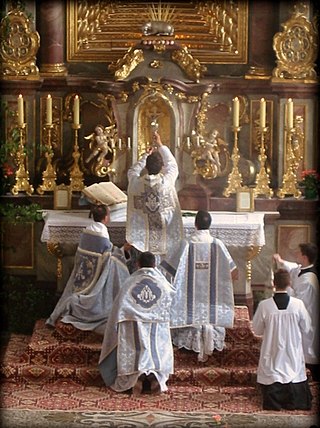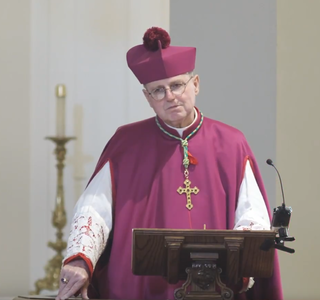
The pope is the bishop of Rome and the visible head of the worldwide Catholic Church. He is also known as the supreme pontiff, Roman pontiff, or sovereign pontiff. From the eighth century until 1870, the pope was the sovereign or head of state of the Papal States, and since 1929 of the much smaller Vatican City state. The reigning pope is Francis, who was elected on 13 March 2013. From a Catholic viewpoint, the primacy of the bishop of Rome is largely derived from his role as the apostolic successor to Saint Peter, to whom primacy was conferred by Jesus, who gave Peter the Keys of Heaven and the powers of "binding and loosing", naming him as the "rock" upon which the Church would be built.

Sedevacantism is a traditionalist Catholic movement which holds that since the 1958 death of Pius XII the occupiers of the Holy See are not valid popes due to their espousal of one or more heresies and that, for lack of a valid pope, the See of Rome is vacant. Sedevacantism owes its origins to the rejection of the theological and disciplinary changes implemented following the Second Vatican Council (1962–1965).
Lucian Pulvermacher was a traditionalist schismatic Roman Catholic priest and a modern-day antipope. He was the head of the True Catholic Church, a small conclavist group that elected him Pope Pius XIII in Montana in October 1998. At the time of his death, he lived in Springdale, Washington, United States.

Pierre Martin Ngô Đình Thục was a Vietnamese Catholic prelate who served as the Archbishop of Huế in the Republic of Vietnam from 1960 until 1968. He later lived in exile in Europe due to unrest in his country and became a sedevacantist bishop who was excommunicated twice by the Holy See of the Roman Catholic Church but is believed to have reconciled with the Holy See before his death in 1984.

Traditionalist Catholicism is a movement that emphasizes beliefs, practices, customs, traditions, liturgical forms, devotions and presentations of teaching associated with the Catholic Church before the Second Vatican Council (1962–1965). Traditionalist Catholics particularly emphasize the Tridentine Mass, the Roman Rite liturgy largely replaced in general use by the post-Second Vatican Council Mass of Paul VI.
The Oath Against Modernism was instituted by Pope Pius X in his motu proprioSacrorum antistitum on September 1, 1910. The oath was required of "all clergy, pastors, confessors, preachers, religious superiors, and professors in philosophical-theological seminaries" of the Catholic Church. It remained in force until the Congregation for the Doctrine of the Faith, with the approval of Paul VI, replaced it with a revised Profession of Faith on July 17, 1967.

Sede vacante refers, in the Canon Law of the Catholic Church, to the state during which a diocese or archdiocese is without a prelate installed in office, with the prelate's office being the cathedral. The term is used frequently in reference to papal vacancies occurring upon the Pope's death or resignation.

A papal conclave is a gathering of the College of Cardinals convened to elect a bishop of Rome, also known as the pope. Catholics consider the pope to be the apostolic successor of Saint Peter and the earthly head of the Catholic Church.
A papal renunciation also called a papal abdication, occurs when the current pope of the Catholic Church voluntarily resigns his position. As a pope's time in office has conventionally lasted from his election until his death, a papal renunciation is an uncommon event. Before the 21st century, only five popes unambiguously resigned with historical certainty, all between the 10th and 15th centuries. Additionally, there are disputed claims of four popes having resigned, dating from the 3rd to the 11th centuries; a fifth disputed case may have involved an antipope.

Ennio Antonelli is an Italian prelate of the Catholic Church who was president of the Pontifical Council for the Family from 2008 to 2012. He has been a bishop since 1982, serving as bishop of Gubbio from 1982 to 1988, archbishop of Perugia from 1988 to 1995, and archbishop of Florence from 2001 to 2008. He led the Italian Episcopal Conference from 1995 to 2001 and was raised to the rank of cardinal in 2003.

In the papal conclave held from 14 to 16 June 1846, Giovanni Maria Mastai Ferretti, Bishop of Imola, was elected on the fourth ballot to succeed the recently deceased Gregory XVI as pope. He took the name Pius IX. Of the 62 members of the College of Cardinals, 52 assembled in the Quirinal Palace, one of the papal palaces in Rome and the seat of two earlier 19th century conclaves. The conclave was the last to elect a ruler of the Papal States, the extensive lands around Rome and Northern Italy which the Catholic Church governed until 1870.
The Society of Saint Pius V is a traditionalist Catholic society of priests, formed in 1983, and based in Norwood, Ohio, United States. The society's original headquarters was based in Oyster Bay Cove, New York. The society broke away from the Society of Saint Pius X (SSPX) over liturgical issues.
Michel-Louis Guérard des Lauriers was a French Dominican theologian and, later in life, a Traditionalist Catholic bishop who supported sedevacantism and sedeprivationism and was excommunicated by the Holy See.

Robert Fidelis McKenna was an American Catholic bishop of the Dominican order. He was known for his traditionalist Catholic positions and was an advocate of sedeprivationism. McKenna was one of the leaders of the Orthodox Roman Catholic Movement (ORCM). He was also known from the Fox TV-movie The Haunted, which is about the Smurl haunting where McKenna conducted two exorcisms.

Some hold the conspiracy theory which asserts that the conservative Cardinal Giuseppe Siri, then the Archbishop of Genoa, was elected pope in the 1958 papal conclave, taking the name Pope Gregory XVII, but that his election was suppressed. Siri did not associate himself with this idea.

The Institute of the Mother of Good Counsel is a sedeprivationist traditionalist Catholic religious congregation based in Italy.

Louis-Marie de Blignières, born Olivier de Blignières on April 11, 1949 in Madrid) is a French traditionalist Catholic priest, and the founder of the Fraternity of Saint Vincent Ferrer.

The papal conclave held from 16 to 18 December 1352 was convened after the death of Pope Clement VI and elected as his successor Cardinal Etienne Aubert. The fifth pope of the period of the Avignon Papacy, he took the name Innocent VI. This conclave is remarkable because during its celebration cardinals for the first time in history subscribed the electoral capitulation, which limited the power of elect.
Conclavism is the practice that has existed since the second half of the 20th century which consists in the convening of a conclave to elect rival popes (antipopes) to the current pope of Rome. This method is used by some Catholics, often Sedevacantists, who do not accept the legitimacy of their present papacy. Those who hold the position that a conclave can be convened to elect a pope to rival the current pope of Rome are called conclavists.

Donald J. Sanborn is an American Traditionalist Catholic bishop who is known for his advocacy of sedeprivationism. He currently serves as the superior general of the sedevacantist Roman Catholic Institute (RCI) and rector of the sedevacantist Most Holy Trinity Seminary in Reading, Pennsylvania, United States.












